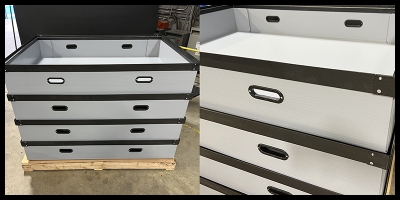Handling Packaging - Returnable vs Expendable
There are many different names for it – returnable, reusable, sustainable, etc. – but however you refer to it, reusable packaging is a superior way to protect your products and eliminate costs all around the supply chain within your company. It's durable and will last longer than cardboard. Depending on the care and use, customers can expect 100+ uses out of a reusable container. These sustainable shipping options come in the form of trays, containers, pallets, cases, and more.
Characteristics of Corrugated Plastic:
- Tear resistant
- Easily takes the place of cardboard expendable packaging
- Easy to score, fold, drill, and stitch
- Fits right where cardboard containers have been used
- Resilient to impact and breakage
- Comes in a variety of in-stock colors
Corrugated plastic serves as a middle ground between cardboard and wood in packaging systems. Corrugated plastic outperforms traditional cardboard packaging. More cost-effective on a cost-per-trip basis, studies have shown manufacturers can save up to 70% in costs when converting from expendable to reusable packaging.
Benefits of Corrugated Plastic:
- Durable & Reusable – Unlike cardboard, corrugated plastic holds up well after repeated usage and is resistant to puncture, tearing, and impact damage.
- Lightweight – Shipping solutions made with corrugated plastic are lighter than their wood or cardboard counterparts, which can reduce fuel transport costs and improve worker safety.
- Moisture resistant – When exposed to moisture, corrugated plastic containers retain their strength, shape, and integrity, providing superior product protection. Being waterproof, corrugated plastic will not mold, mildew, or rust. This also improves the working environment and worker safety for employees since the corrugated plastic boxes hold up when cardboard boxes fail.
- Available in various constructions – Corrugated plastic dunnage inserts and containers can be designed to accommodate a range of packaging solutions where wood or cardboard are typically used. If you are converting from cardboard to plastic, you don’t have to change your process to accommodate a new packaging material design.
Benefits of Returnable Packaging and Reusable Containers:
- Reduce Overall Shipping Costs – What draws most to and is definitely the biggest benefit of reusable packaging is that overall shipping costs are reduced through consistent and repeated use. You will save money by eliminating single-use shipping containers and packaging and get multiple uses out of durable solutions.
- Safer Delivery – Another benefit is providing superior protection for the products getting shipped in the packaging. Along with your custom-designed package, if it is needed, custom-designed dunnage will also be an additional protective tool for your product.
- Reduce Freight Costs – Freight can be used more efficiently as well when the conversion takes place. To eliminate wasted space and to aid in the loading and unloading of deliveries, reusable packaging can be stacked easier, as a plastic corrugated box or plastic container will hold its shape superiorly when compared to cardboard.
- Fewer Workplace Injuries – Workplace injuries can be avoided when boxes require being cut open. Your custom packaging can have, for example, Velcro added for ease of opening and closing. There are many options and only your specific order will determine what the best method for closing a box is. To eliminate surprises, custom packaging will keep sharp parts from cutting through and keep everything in its place.
Questions about Returnable Packaging?
Get A FREE Sample Kit
